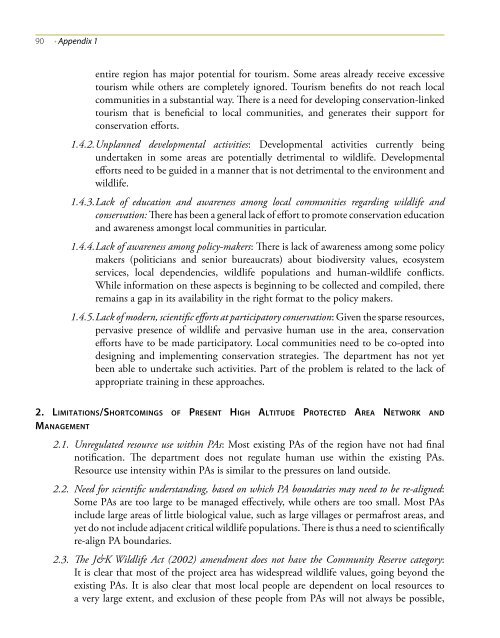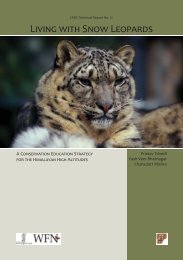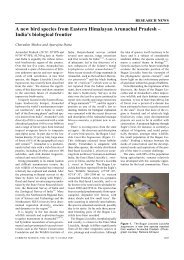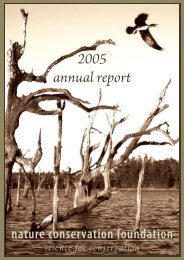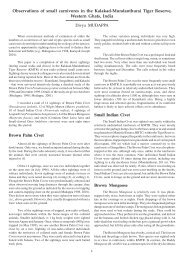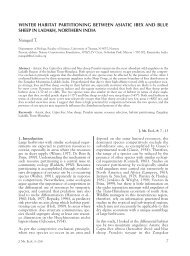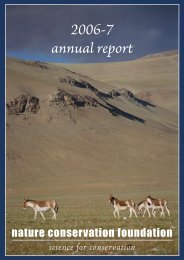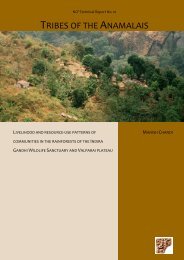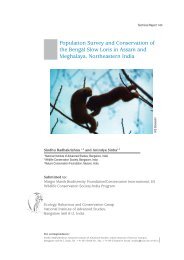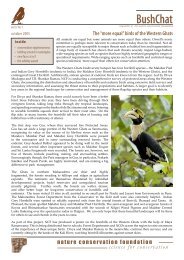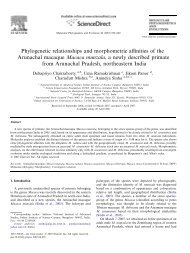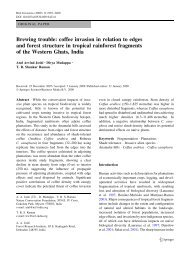towards project snow leopard - Nature Conservation Foundation
towards project snow leopard - Nature Conservation Foundation
towards project snow leopard - Nature Conservation Foundation
Create successful ePaper yourself
Turn your PDF publications into a flip-book with our unique Google optimized e-Paper software.
90 • Appendix 1<br />
entire region has major potential for tourism. Some areas already receive excessive<br />
tourism while others are completely ignored. Tourism benefits do not reach local<br />
communities in a substantial way. There is a need for developing conservation-linked<br />
tourism that is beneficial to local communities, and generates their support for<br />
conservation efforts.<br />
1.4.2. Unplanned developmental activities: Developmental activities currently being<br />
undertaken in some areas are potentially detrimental to wildlife. Developmental<br />
efforts need to be guided in a manner that is not detrimental to the environment and<br />
wildlife.<br />
1.4.3. Lack of education and awareness among local communities regarding wildlife and<br />
conservation: There has been a general lack of effort to promote conservation education<br />
and awareness amongst local communities in particular.<br />
1.4.4. Lack of awareness among policy-makers: There is lack of awareness among some policy<br />
makers (politicians and senior bureaucrats) about biodiversity values, ecosystem<br />
services, local dependencies, wildlife populations and human-wildlife conflicts.<br />
While information on these aspects is beginning to be collected and compiled, there<br />
remains a gap in its availability in the right format to the policy makers.<br />
1.4.5. Lack of modern, scientific efforts at participatory conservation: Given the sparse resources,<br />
pervasive presence of wildlife and pervasive human use in the area, conservation<br />
efforts have to be made participatory. Local communities need to be co-opted into<br />
designing and implementing conservation strategies. The department has not yet<br />
been able to undertake such activities. Part of the problem is related to the lack of<br />
appropriate training in these approaches.<br />
2. Limitations/Shortcomings of Present High Altitude Protected Area Network and<br />
Management<br />
2.1. Unregulated resource use within PAs: Most existing PAs of the region have not had final<br />
notification. The department does not regulate human use within the existing PAs.<br />
Resource use intensity within PAs is similar to the pressures on land outside.<br />
2.2. Need for scientific understanding, based on which PA boundaries may need to be re-aligned:<br />
Some PAs are too large to be managed effectively, while others are too small. Most PAs<br />
include large areas of little biological value, such as large villages or permafrost areas, and<br />
yet do not include adjacent critical wildlife populations. There is thus a need to scientifically<br />
re-align PA boundaries.<br />
2.3. The J&K Wildlife Act (2002) amendment does not have the Community Reserve category:<br />
It is clear that most of the <strong>project</strong> area has widespread wildlife values, going beyond the<br />
existing PAs. It is also clear that most local people are dependent on local resources to<br />
a very large extent, and exclusion of these people from PAs will not always be possible,


